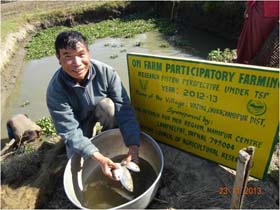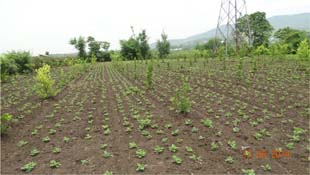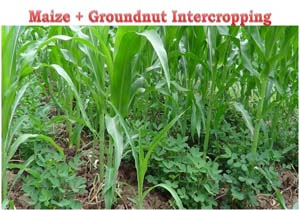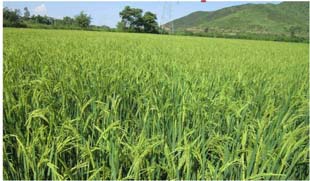Integrated Farming System Enhanced Livelihood of Tribal Farmers
Manipur is entirely rainfed and rice occupies more than 80% of the agricultural area in the kharif season. The landholdings are small and the farmers practice subsistence farming for their livelihood. The North Eastern people are meat lovers and a huge demand exists for poultry, pork and other meat products. Invariably, there exist deficit in crops, livestock and fishery products. Hence, in order to maximize farm productivity, the technological interventions through Integrated Farming System were adopted in participatory mode by the ICAR Research Complex for NEH Region, Manipur Centre, Imphal.
Technological Interventions
Considering the physical, social and economic limitations of the Manipur, an integrated farming system model was developed in the field of Henkpao (Tribal farmer) in Tollen village, Churachandpur district of Manipur during 2011–12 to 2013–14. The model comprises four ha of fenced area in the vicinity of the tribal settlement integrated with seven components. With the assistance of Tribal Sub-Plan, technological interventions was made through high yielding variety Paddy (RCM-9), Maize (Pusa composite-3), groundnut (ICGS- 76), pea (Azad pea-1), vegetables [cabbage (Rareball) and cauliflower (Early Hemlata)], fruits (50 tree bean, 50 kachai lemon and 50 orange), six piglets (Cross bred Hampshire), 125 poultry (Gramapriya), fishery (fingerlings of Common carp, grass carp and Catla), agri- polythene sheets of 250 micron meant for Jalkunds and vermicomposting unit for waste recycling. The capacity building programme on Integrated Farming System was conducted to the villagers in whom the beneficiary farmer also participated.
Impact
Mr. Henkpao successfully harvested higher paddy under IFS 4.80 t/ha after intervention as compared to 3.25 t/ha rice yield before intervention. Farmer had grown first time groundnut (ICGS-76) which gave 2.40 t/ha dry pod yield. Maize cultivar Pusa composite-3 produced 3.25 t/ha as compared to local maize cultivar (Chakhaocujak (hill)) yield 1.70 t/ha. The vegetable yield considerably increased after intervention which gave 1.50 lakh net returns from cabbage and cauliflower. In the 2nd year, the number of piglets increased to 15 including with six pigs. In poultry farming, Gramapriya is performing well and farmers were getting 40-45 eggs/day. He adopted composite fish production in which grass carp was surviving on middle and upper layers of water and common carp in lower layers of water. In 2011-12, the farmer had no water harvesting unit. In 2013-14, he could store 30,000.00 litres of water in the Jalkund. In improved practice, from four ha land he earned the total net returns Rs 3,63,500/ [(Paddy cultivation (2 ha)= Rs 82000, Groundnut production (0.5 ha)= Rs. 38000, Maize production as green cob (0.5 ha)= Rs. 23000, Vegetable production in rabi season (1 ha, Cabbage and Radish)=Rs. 150000, Fruit production (Fruiting not started)=Nil, Piggery= Rs. 37000, Poultry= Rs. 16000, Fishery= Rs. 17500] as compared to 105000 in 2011-12.
Now, he has become a role model for not only in his village but also for the entire tribal community of this district. Now, farmers from other villages were motivated by the success of these farmers and most of the village headmen are requesting to implement such model in their villages. These interventions made a positive impact on the utilization of scarce resources under fragile hilly ecosystem benefitting tribal farmers at large.
The same model is being replicated at beneficiary Kagungai, Peace land, Tamenglong district, Somi of Nungshong village, Ukhrul district, H. B. Starson, Chandel Khullen, Chandel district and R. D. Peter of Purul Akutpa village, Senapati district.



